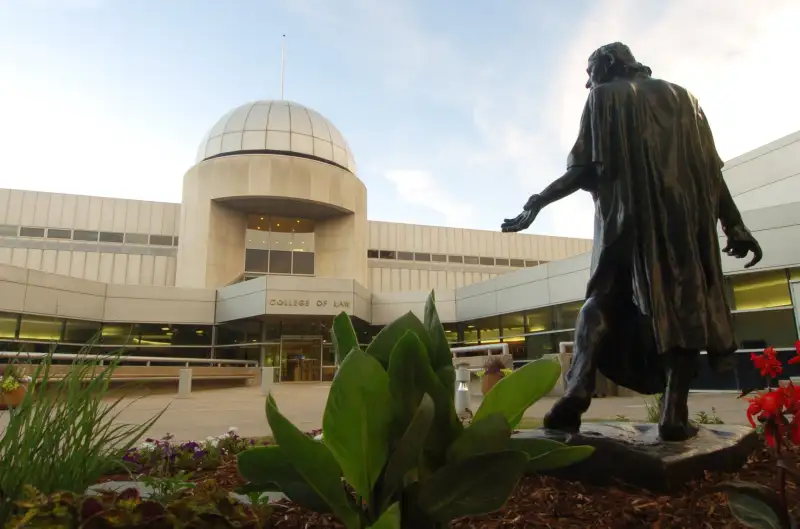Law School Goes On Sale—Up to 20% Off!

Law school applicants and students could be in for some sticker shock—the good kind—thanks to a growing trend of price slashing at schools.
The University of Arizona announced last week that it would be dropping nonresident tuition rates by about 30%, from $42,000 a year to $29,000. This is the second round of cuts for the school, which dropped tuition for the 2013-14 school year by 11% for in-state students and 8% for out-of-state students.
A handful of other law schools have made similar moves.
The University of Iowa reduced tuition by 16% for fall 2014. Penn State slashed tuition by nearly 50% for in-state students in the class of 2014 by offering annual $20,000 tuition discounts. Roger Williams University School of Law in Rhode Island reduced tuition by 18% for the upcoming school year and plans to freeze rates there for three years. Ohio Northern University cut its tuition by 25% this fall. The Brooklyn Law School will cut tuition by15% starting in the 2015-2016 academic year.
Plus, the University of Maryland and University of Massachusetts have both frozen tuition in the past two years.
"Law school is too expensive," explains Judith Areen, executive director of the Association of American Law Schools and a law professor at Georgetown University Law Center. "Significant drops in enrollment, almost by a third in three years, have put pressure on schools to find the right balance between cost and quality. I applaud these schools for trying to innovate and offer their programs at the lowest price they can."
Why tuition is dropping
Like any good sale, these new prices are intended to woo prospective customers—in this case, students—while turning up the heat on the competition. For many mid-tier law schools, change has become necessary as they deal with how drastically demand for their product has fallen off in the past three years.
First-year enrollment at U.S. law schools fell 11% from 2012 to 2013, according to the American Bar Association, bringing the total number of students enrolled down to 39,675 or where the figure sat in 1977, when there were far fewer ABA-accredicated schools.
And two-thirds of ABA law schools reported declines in the size of their enrollment in 2013; 81 schools experienced a decline greater than 10%.
The steep decline in enrollment over the past three years—in 2010 enrollment was over 52,000—highlights the lingering effects of the recession on the legal profession. Students are steering away from the traditionally high-salaried career as it has left many graduates loaded with debt and struggling to find work in the field. "The problem is contraction in the job market: The recession cut back the number of jobs and now fewer law graduates are needed," says Areen.
Not every school will formally reduce its tuition, but that doesn't mean you might not be able to get in for less. "I'm sure every dean would like to offer lower prices, but not all can," says Areen. "Instead, we will likely see a greater range of tuition available across the country. And the greatest difference will be on an individual basis, which means more to students than just sticker price."
For example, some schools have responded by offering more merit-based scholarships—as Villanova University's law school has done. Starting this year, Villanova will cover tuition for high-achieving students with GPAs above 3.6 and LSAT scores of at least 157 for all three years of law school.
"These kinds of tuition cuts will certainly be an incentive to students to choose that school over another pricer school," says Halimah Najieb-Locke, national chair of the National Black Law Students Association. "Students were already doing cost-analysis on different schools, and on the level of debt they would take on, but now I think we'll see much more of this dollar amount comparison pulling kids away from what might have once been their dream law school."
Of course, the true dream law schools aren't joining the price-slashing revolution. Top schools like Yale, Harvard, and Stanford remain in high demand with applicants because of their brand recognition and graduate placement records. But savvy students may be able to use the cost-cutting of other schools as a bargaining chip with even these top schools.
How to use this trend to your advantage
A student who applies to multiple schools can use acceptance letters from cheaper schools as leverage to sway their top-pick school to sweeten its own offer. Simply let the school you prefer know you've been accepted elsewhere, and what that other university has offered you, says Areen. Ask your preferred school if they can do anything more for you, and you might come away with a better scholarship offer.
Najieb-Locke adds that when you do approach schools about increasing scholarship amounts, you should make sure you can make a good case for why you want to attend that school, what you plan to do with a degree from that institution, and why you'd make an attractive student and future alumn.
"If your desire seems genuine, and you've framed the conversation around how a certain lack of funding—always have a specific number in mind—is holding you back from achieving your dreams," says Najieb-Locke, "schools are much more likely to grant your request than if you simply say 'what more can you give me?'"
Even after students have made their law school selections, they could still be feeling the boon of the drop in demand three years later. As grads, they will potentially come out of school with less debt. And, says Areen, a smaller pool of graduates means less competition for jobs.
